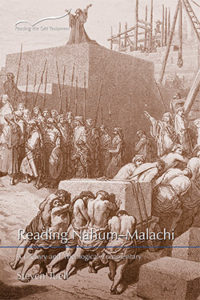
Reading Nahum-Malachi: A Literary and Theological Commentary
Steven Tuell. Reading Nahum-Malachi: A Literary and Theological Commentary. Macon, GA: Smyth and Helwys, 2016, 304 pp. $33.00.
Reviewed by Jonathan Mellison
In this commentary on the final six prophetic books (Nahum–Malachi) from the collection often referred to as the “Minor Prophets,” Steven Tuell seeks to engage these books in a way that honors their collective identity. He observes that many ancient readers saw a unity in these books, and these books bear evidence of redactional links tying them together (2). Tuell strives to combine literary and theological scholarship in a manner that is accessible to the lay reader. Each book is treated by itself, but Tuell also discusses each book’s relationship to the others in the larger collection. Tuell begins his treatment of each book by discussing theological questions raised by the book and then considers issues of authorship, date, and setting, before moving into a closer reading of the text.
Tuell moves through each book in its canonical order, and he seeks to provide a reading that is informed by the work of contemporary, critical scholars while also being sensitive to the needs of the Christian church. Namely, Tuell addresses challenging issues raised by each prophet, but he also addresses issues pertinent in Christian circles today. For example, he observes that the “day of wrath” is one challenging theme for modern readers of Zephaniah, but that wrath can have a positive outcome. He suggests that the day of wrath is ancient Israel’s way of interpreting its suffering in a way that functions as a “potent strategy for survival” (110). He then moves to contemporary circumstances and suggests that suffering in our lives “may drive us to realize our own inadequacy and vulnerability, and therefore lead us to confession, new life, and deepened faith” (110).
Tuell’s commitment to reading these books as part of a unified collection is perhaps best exemplified in his introduction to Nahum. He observes that Nahum does not appear in the Common Lectionary, because it “gloats over the collapse of Assyria’s capital Nineveh. . . . its siege becomes a mugging and its fall a rape” (11). However, Tuell notes that the redactors of the Twelve have joined Nahum and Habakkuk by starting Nahum with a psalm, and ending Habakkuk with another psalm. Thus, the angry God who punishes Assyria also “addresses Judah’s own acts of injustice and oppression” (12). For Tuell, pairing these two together inside the context of the Twelve “prevents the careful and caring reader from an uncritical embrace of Nahum’s simplistic, black and white ideology” (12).
As a whole, the scope of this book is ambitious; each of these six books has its own peculiarities, and Tuell’s engagement shows the breadth of his scholarly interests. This breadth of scholarly interests, however, often means that the focus is not as sharp as it could be. This commentary series seeks to offer a literary and theological reading of biblical texts, and that endeavor often diffuses the focus; Tuell tends to get sidetracked in his efforts to provide a commentary on the texts that is both literary and theological. For example, his introduction to Zechariah notes, “By twenty-first-century Western standards, one could think that Zechariah was insane” (161). This is in reference to the eight visions that form the content of Zechariah’s prophetic material. In the paragraphs following this statement, he makes observations that contemporary psychologists have shown that hearing voices is not necessarily indicative of insanity, and he ultimately wonders if our “society’s standards of mental illness apply to Zechariah or to his fellow prophets” (162). Even though scholars generally engage prophetic material in its own right—without questioning if the person was sane—Tuell’s devotion of several pages to this discussion makes the question a sort of “damnation by unnecessary defense” to Zechariah.
This lack of focus is also evident in the layout of the book. For example, in one section, Tuell moves from quoting C. S. Lewis and megachurch pastor Rob Bell to a discussion around the Canaanite god Ba’al. His quick shifts between engagement of pop culture, technical scholarship, and theological concerns are a bit jarring for the reader. All of these observations are joined under sparse headings, making it difficult to study shorter passages of biblical text. Though it is evident that Tuell has worked to engage major scholars in his preparation of this commentary, his own voice and scholarly work fail to come off the page in a clear way.
This book offers a valuable synthesis of scholarship, but the specialist will likely find Tuell’s commentary to be too general. And, though Tuell provides decidedly theological conclusions to his study of these texts, this commentary’s lack of focus makes it a less-than-ideal tool for use in preparation of papers or sermons.
Jonathan Mellison, MDiv Student, Princeton Theological Seminary
